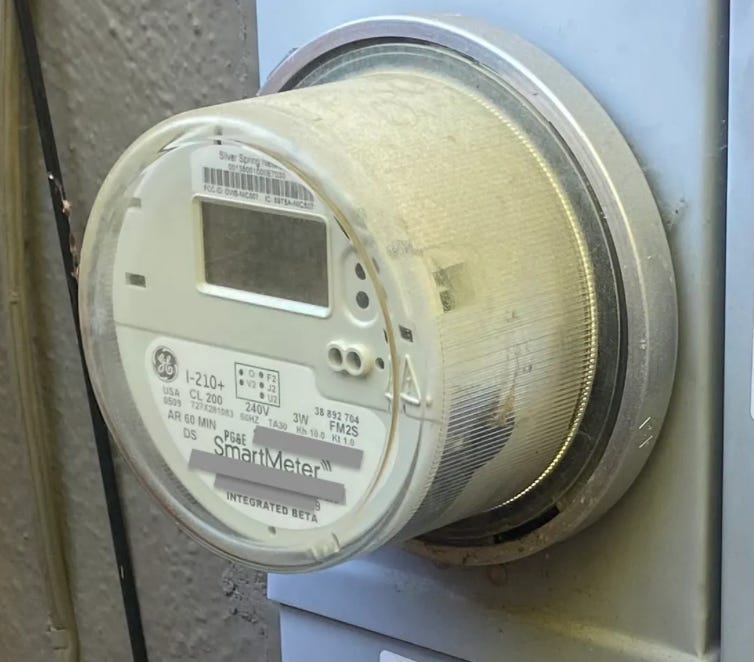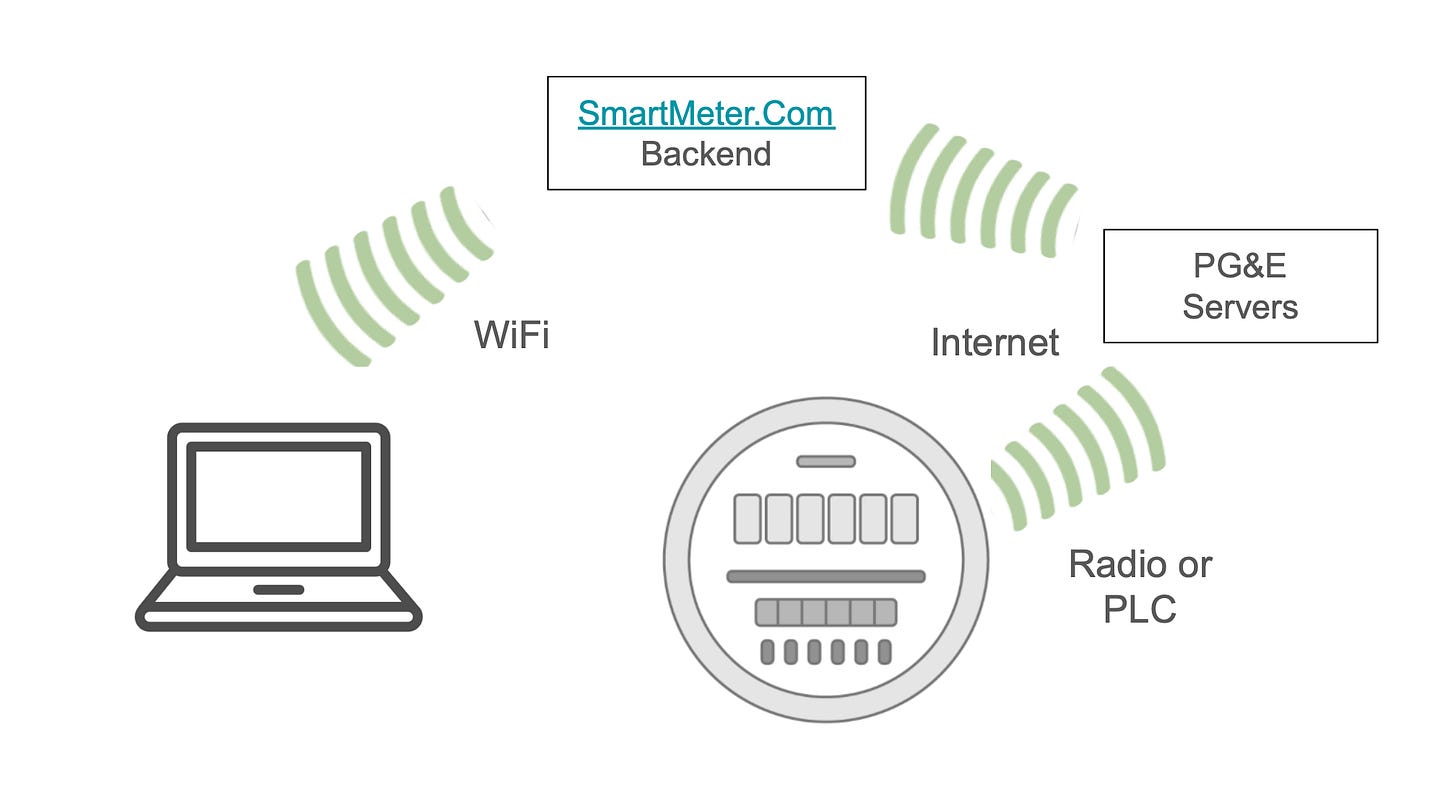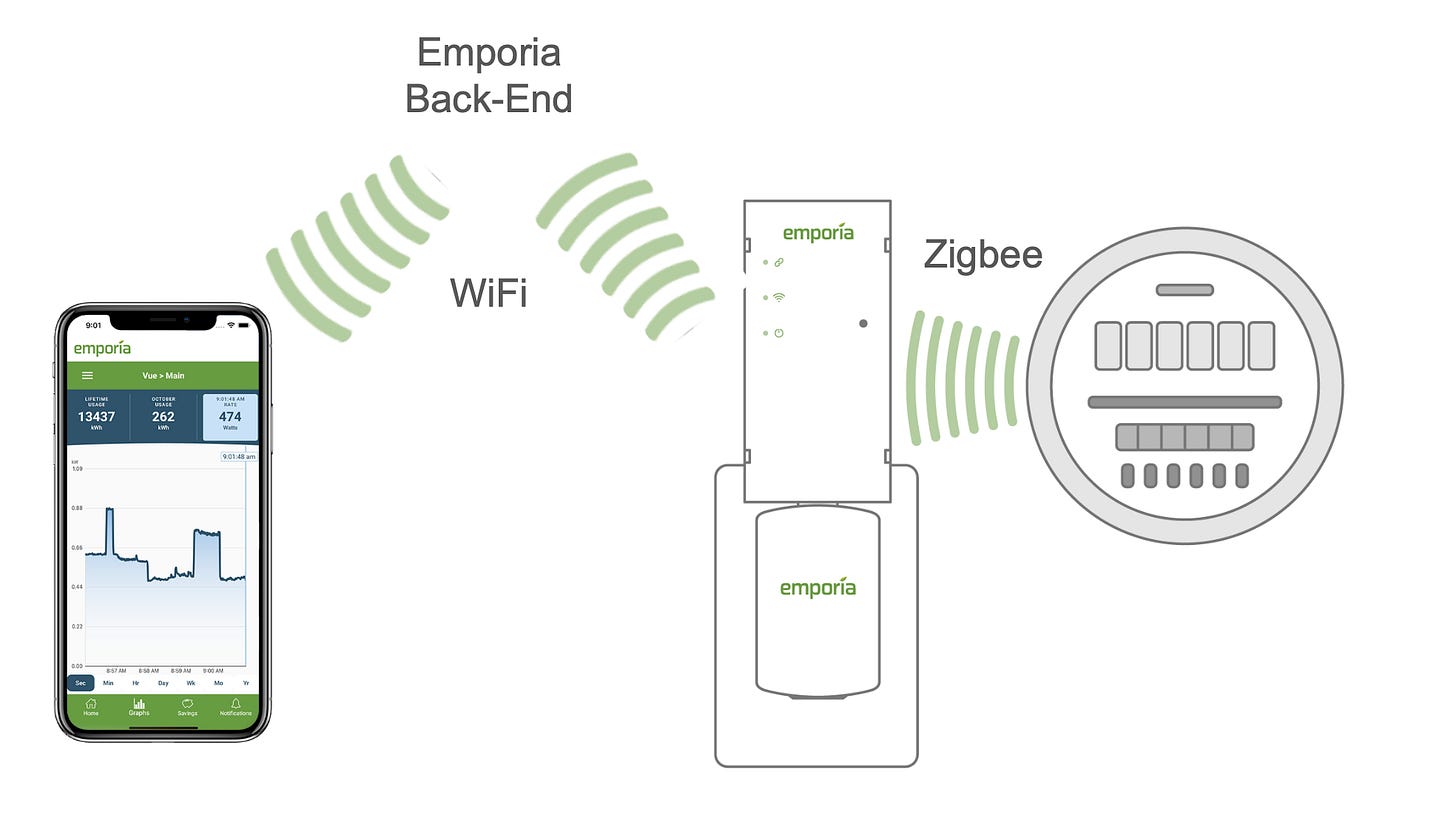Dynamic Rates - Awaiting a Promise from 2001
California's ratepayers have paid $4.5 Billion for Smart Meters but we still don’t have dynamic rates
Summary
Although California has recognized the benefits of dynamic rates for years, residential dynamic rates are not yet available to most customers. In this post I provide some background on the topic and discuss a new bill, AB-1117 (Schultz, 2025) that tries to deliver optional dynamic rates.
Context
Time Varying Rates
A time-varying rate is one where the price of the electricity varies over time. Two types of time-varying rates are Time of Use rates (TOU) and Dynamic Rates (sometimes called Real Time rates, or Flexible Rates).
TOU Tariffs
In a TOU tariff, the $/kwh rate of the electricity depends on the time of day; a common arrangement has 3 periods, Peak, Partial Peak and Off Peak, with rates within a period fixed except for possible seasonal changes. For example, right now our EV2-A Peak rate is $0.62277 while our EV2-A Off Peak rate is $0.31026; this represents a spread of 2x between the highest and the lowest rates.
If you are interested in TOU tariffs, check out my post on the topic.
Dynamic Rate Tariffs
In a Dynamic Rate tariff, the rate may change through out the day and may depend on the location of the customer within the grid. Ideally a Dynamic rate captures the real cost of delivering electricity at a given location and at a given time incorporating generation costs as well as congestion costs in the transmission and the distribution grid. In California this may yield large spreads in the total electricity cost; see further below.
If you are interested in the nuances of the Electric Market, check out my post; it covers concepts like LMP and DLAPs.
Dynamic Rates provide the Right Grid Signal
A dynamic rate provides a signal to which customers can respond. A regular consumer will use the signal in importing decisions: maximize imports when the energy is abundant and cheap and minimize them at other times. A consumer-producers will use the signal to make import and export decisions.
Dynamic rates encourage participants to be good grid citizens: import when energy is cheap and abundant, and, if possible, export when it is scarce
Flexible Loads, Then and Now
Dynamic Rates rely on the ability of the customer to adjust its load, in either quantity or in timing. Strategies may involve avoiding a load altogether (e.g avoid using some tool in your workshop that uses a lot of energy), modify the time where the load occurs (e.g. charge the EV at cheaper times) or time-shift the load using some type of energy store.
Energy stores traditionally used to provide load flexibility are thermal stores like our water heaters and the house air/mass in an HVAC. In more recent times we have seen a wider adoption of electrochemical stores like Lithium-Ion batteries, which may be embedded in an appliance like the Copper Stove and the HVAC proposed by Carrier, or it can be a singular battery in the house/building (see my post on Modern Residential Batteries), or in an EV if it supported bidirectional charging.
In our household we do load-shifting on our EV charging, both to reduce cost and to reduce GHG emissions. We have a large (80 gallon) HP WH that is aware of TOU rates and does load-shifting. Our EV does not support bidirectional charging.
Batteries open many opportunities for load management. If interested check my posts on a Battery-First approach, Time-Shifting your consumption, and Smart Meter Adapters.
The Road to Dynamic Rates
Dynamic Rates were required in 2001
California recognized early the value of dynamic rates. In 2001, AB-29 (Kehoe) was passed by the legislature, was signed by Governor Gray Davis and was chaptered. Article 3.5 of the Public Utilities Act explicitly requires the use of real-time metering and pricing programs for producer-consumers. The whole Section 353.3 is worth a check (it’s short), but quoting from there:
353.3(b) each customer with distributed energy resources that meet the criteria of Section 353.1 shall participate in a real-time metering and pricing program, when these programs become available, …
Prior to the time these programs become available, the customer shall participate in a time-of-use pricing tariff. On or before December 31, 2001, the commission shall adopt a real time pricing tariff for the purpose of this section.
Section 353.3 was added in December 2001, almost 24 years ago.
Smart Meter Deployment - RatePayers paid $4.5 Billions
Practical application of dynamic rates requires deploying Smart meters. In 2006, the California PUC authorized PG&E to collect $1.68 Billion from customers to deploy smart meter infrastructure (D.06-07-027). This was expanded over time and all together the CPUC has authorized the 3 large IOUs to recover $4.5 billion in Smart Meter infrastructure. By now over 98% of their meters are Smart Meters.
I am most familiar with the Smart Meters used in residential houses in the PG&E territory. These units are GE I210+ units (Aclara acquired the Meter division of GE) that track and report imports and exports and that can connect locally using Zigbee and remotely through a mesh connection. In our household we leverage the Zigbee connection through an Emporia Vue Utility Connect to get real-time consumption, and PG&E uses the mesh connection for their metering and billing and the Green Download button. If interested, check my post on the topic.
MIDAS - Market Informed Demand Automation Server
For dynamic rates to be applied they must be made available to different entities. The Market Informed Demand Automation Server (MIDAS) from the California Energy Commission provides access to utilities’ time-varying rates, greenhouse gas emission signals, and CAISO’s FlexAlerts. MIDAS information is available through a simple REST API (see video).
MIDAS has been available since 2021.
…. And Computers
The final piece needed for Dynamic Rates to be deployable at scale is the prevalence of automation through computers. While it is very cumbersome to manually manage the daily changing rates of 24 periods, this can be automated easily using MIDAS and computers.
Some standards are still settling in (most notably some in BiDirectional charging) but right now pretty much everything is in place… except the actual rates!
Current Status
Unfortunately, today dynamic rates are only available to very few California customers.
PG&E Flex Pricing Pilot
The big 3 IOUs are currently running pilots for different classes of customers. I have been tracking the rates for our house’s circuit from PG&E’s Flex Pricing program, a pilot that leverages proposals from CalFUSE.
This spreadsheet has the data for the last year. I may do another post with more details but, as a quick excerpt, last Sunday, July 27, 2025, the rate at 8pm was $0.681 while the rate at noon was $0.127; that is roughly a 5x spread. That spread has been fairly typical in this year’s very mild summer.
Last year we had a harsher summer and we were experiencing wider spreads. One of the largest spreads was on July 8, 2024 when the rate at 7pm was $1.131, while most of the day the rate was around $0.04, for a rate spread of 28x.
Applied to Consumer-Producers
One of the things I really like about the Flex Pricing rate is that it reflects the actual cost. The rate applies to consumer-producers which means I can use it to answer a question I’ve had for a while: how often is exporting to my local grid beneficial to the grid? The answer is almost always! In over 10,100 hours, only 200 hours had a negative dynamic rate value.
Note that if we used this rate we would automatically get a two-way tariff (see my post) that reflects real cost.
Direct Energy and Dynamic Rates
The PG&E pilot is good but it is yet another pilot. What we need is a real rate and at this time I only know of one Load Serving Entities that is providing dynamic rates, a Direct Access provider called Direct Energy Services, which is part of NRG. I don’t know how many customers does DES have in California, though that number is currently capped by regulation.
Note - In 2024 I wrote a note Comparing PG&E to CCAs and POUs but I overlooked the role of Direct Access providers. I hope to address that at some point in the future.
Impact of Dynamic Rates to Customers
Dynamic rates would help customers that would choose to adopt them, and those that would not.
Customers Adopting Dynamic Rates
A customer that chooses to adopt dynamic rates can do so for two reasons.
The first reason is that the rate spread in a dynamic rate significantly increases the opportunities for load shifting and time-shifting, which can yield substantial financial benefits. Add batteries that are reacting dynamically to the signal from MIDAS and this is a big opportunity. For both consumers, and for consumer-producers.
The second is that the rate may actually be cheaper for their existing load profile. A 2017 study of ComEd’s dynamic pricing program found that 97% of households would have saved money had they opted into the dynamic pricing tariff even without changing their consumption pattern.
All Customers
Dynamic rates will benefit all customers, even those NOT adopting them. This is because the main driver for our high electrical rates is the build up of the grid to satisfy peak demand. Load management reduces the need for that build up, and dynamic rates create an incentive for consumer-driven load management. By having some customers adopt dynamic rates we reduce the rates for everybody.
Dynamic Rates are good for all customers.
Enter AB-1117
What is it
AB-1117 was introduced by Assemblymember Nick Schultz. The original scope covered two areas (copied from Bill Analysis)
The CPUC must develop optional dynamic rate tariffs applicable to each large electrical corporation for their customers, specifically by July 1, 2028 for medium and large commercial and industrial customers, and by July 1, 2030 for residential and small commercial customers.
Additionally, this bill authorizes medium and large commercial and industrial customers to receive generation service through the Direct Access (DA) program, thereby, opening the current statutory cap on this third party service
AB-1117 passed Assembly Floor and the Senate EUC Committee and it is now awaiting the Senate Appropriations Committee (see Schedule). The biggest modification is that the second area was removed in the latest amendment. I regret that as our IOUs deserve all the competition they can get.
I strongly favor this bill; contact your representative if you have an opinion on this topic.
Details
There are a few nuances in AB-1117. The following two were raised by the Bill Analysis:
The original text included generation, transmission and distribution costs. It is not clear if the state agencies can incorporate transmission rates in the rates or if the transmission portion needs to be done by FERC. The current text of the bill notes this and it emphasizes its desire to include transmission costs if at all possible.
There is a concern about “double-counting” between Server-Side Load Management benefits and Demand-Side Load Management. The bill has been adjusted to discuss that.
Finally, I am a tad concerned about the exact phrasing in (3)(A)
(3)(A) a customer of a large electrical corporation with an installed smart meter and who chooses to take service under an optional dynamic rate tariff shall be provided access to their own interval usage data directly from the smart meter as that data is generated.
The intention is great, but there are some nuances depending on the interpretation of “access”, “directly from the smart meter”, and “as that data is generated”. I checked with some people more directly involved in the bill and I was reassured that the intention of this could be satisfied by a solution involving a mobile app or browser providing data with a moderate lag of minutes, not pseudo real-time. See below.
Discussion
Dynamic rates are overdue. I haven’t heard of a real technical reason not to provide them. The data from the Smart Meter will propagate relatively quickly via the mesh network (Wi-Sun) to the PG&E back-ends. I looked for data on propagation time and this article talks about propagation of the order of milliseconds. Add some orders of magnitude and the data should be reaching the PG&E back-ends in minutes. Digesting the data after that, for internal records and/or to present it to the customers, should only take a few seconds after that.
The sketch could be something like this:
As a feasibility proof-point, Emporia provides a similar service from their sensors and the delay between me turning my electric kettle and my Emporia App showing the new load is no more than 15 seconds.
All this is pretty standard fare. There are countless systems out there doing it every day, for much larger volumes than the 15-minute updates from the 15 million smart meters in California. I know PG&E’s back-end needs improving (see my post on their $760M request for a “Billing System”) but this is no excuse. The other IOUs upgraded a while ago (SDG&E in 2017 and SCE in 2021) and, worse case, PG&E can get a competent outside group to do the work.
BTW, Texas provides a system like this at SmartMeterTexas.com.





This is very well documented and has a good proposal for action.
Thought provoking post. Dynamic pricing has many advantages from a pure economics perspective, assuming the residential consumer has (1) clear ability to see the pricing signals, and (2) the ability to act on them (ie, there were clear failures of these mechanisms during the texas storms - https://www.reuters.com/business/energy/texas-freeze-raises-concerns-about-ridiculous-variable-rate-bills-2021-02-23/).
This makes it seem to me that residential automation (to react to price signals) and/or price-protection will be mandatory. Can you do these things without a competitive retail residential electricity market? Right now, I don’t see the incentive for someone to offer the comprehensive residential automation that would be needed to make this more than a very small “niche” of residential users. And given PG&E’s track record and operating model, I wouldn’t count on them for that kind of innovation. Thoughts?